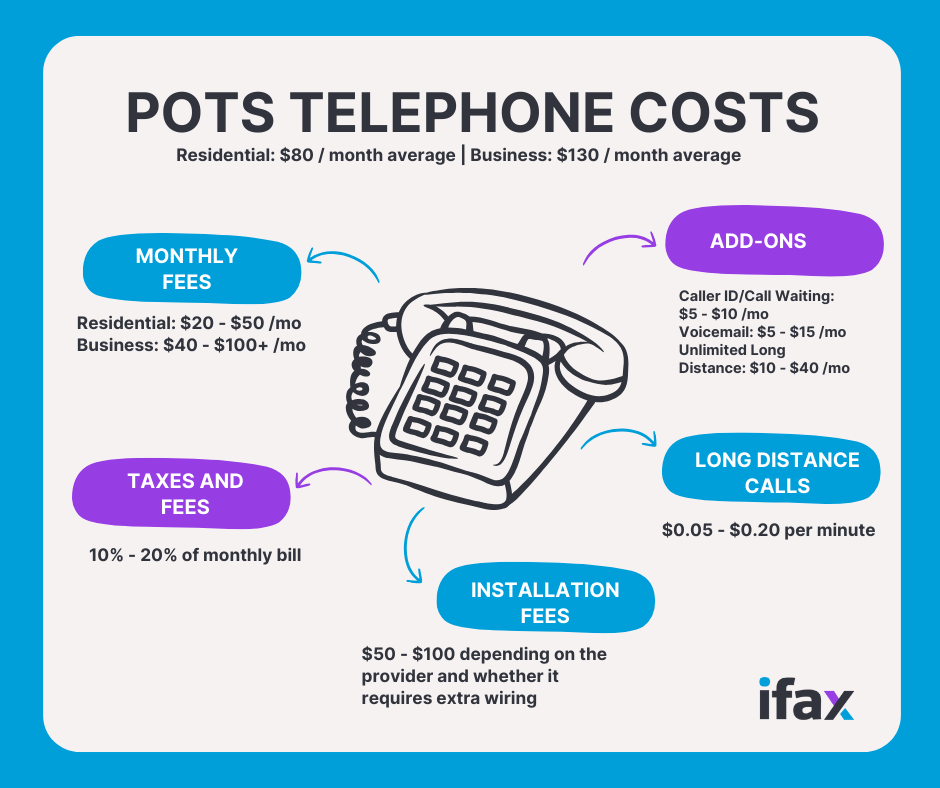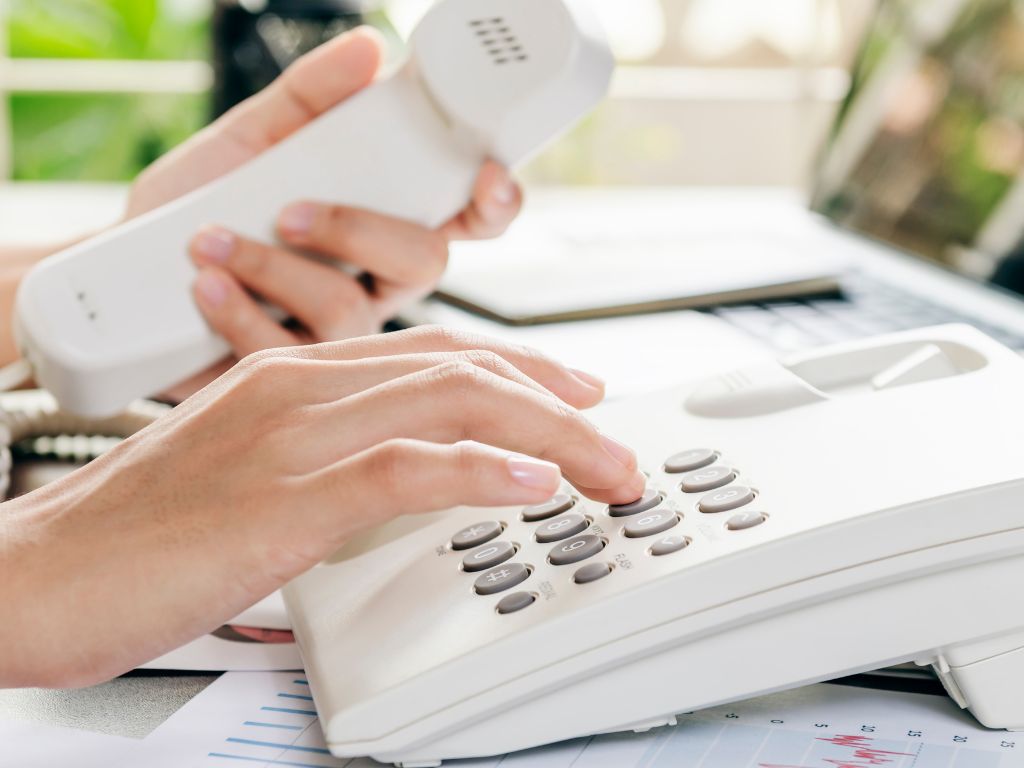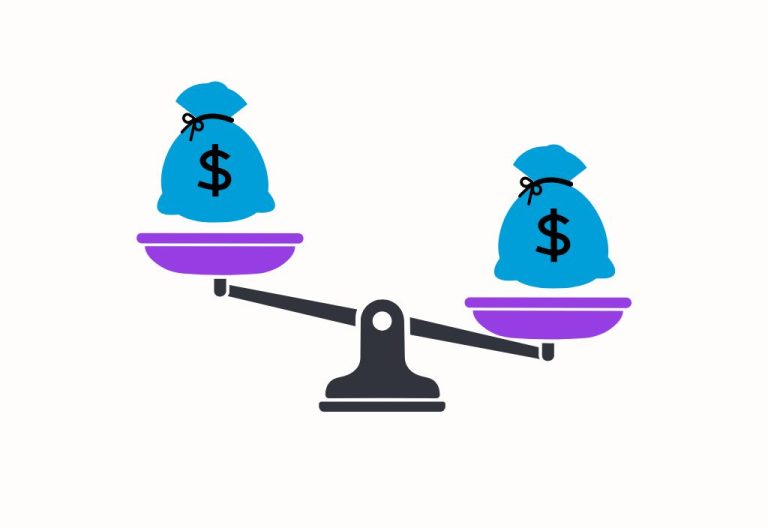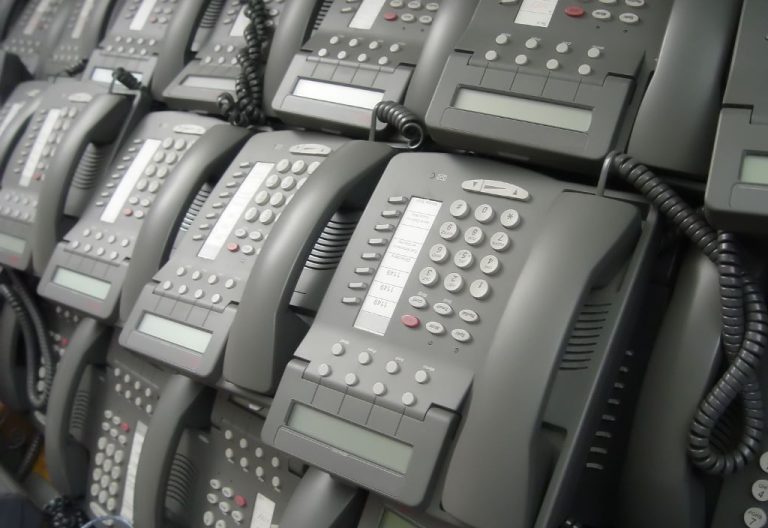POTS (plain old telephone system) has powered traditional landline phones for decades and is now due for an upgrade. Over the years, POTS telephone costs have gotten more expensive as telecommunication companies struggle to support this aging infrastructure. Learn the full costs, benefits, and disadvantages of clinging to this outdated technology.
Table of Contents

Cost of POTS Telephone Service
Different factors affect the costs of POTS telephone service. With the copper switch-off, POTS phone lines are more expensive than their digital counterparts.
Here’s a breakdown of what typically contributes to the cost:
| Monthly Service Fee / Basic Line Rental: | Residential: $20 – $50 per month Business: $40 – $100+ per month |
| Add-on Features: | Caller ID / Call Waiting: $5 – $10 per month Voicemail: $5 – $15 per month Unlimited Long Distance: $10 – $40 per month |
| Taxes and Fees | 10% – 20% of monthly bill |
| Installation Fees | $50 – $100 depending on the provider and whether it requires extra wiring |
| Long Distance Calls | $0.05 – $0.20 per minute |
Historically, POTS lines cost $50 monthly for residential lines, while business lines can go as high as $500 monthly. With the FCC deregulating copper wire services, telecom companies have raised prices to recuperate rising costs for maintaining their copper infrastructure. This has seen monthly bills rise by as much as 649% in a one-month period for some businesses.
As more regions retire their copper wires, costs will continue to increase. Telco companies want consumers to switch to more cost-effective solutions like VoIP, and they offer lucrative deals and bundles to encourage customers to ditch their POTS telephones.
Benefits of POTS Telephone Service
If POTS lines are a dying breed, why should you even consider or cling to them? Several POTS telephone benefits make it hard for those with this service to leave. Here’s why:
Reliability
POTS provides a highly reliable connection that isn’t dependent on internet access or power availability. Traditional POTS lines receive power from the telephone exchange, ensuring the phone works even during power outages (provided you’re using a corded phone). This makes POTS a reliable backup for emergency communications, especially in areas prone to power disruptions.
POTS telephones are available in rural and remote areas with limited or unreliable internet access. POTS lines are also used for alarms, elevators, fax machines, and other equipment that depend on analog connections for reliability.
Simplicity
One of the many pros of POTS telephones is its straightforward application. Using an analog line doesn’t require complex setups, software updates, or troubleshooting. Likewise, you rarely have to deal with technical issues if the provider maintains the infrastructure.
However, with the imminent completion of the copper switch-off, providers are expected to dedicate fewer resources to the timely maintenance of these analog lines.
Security
Copper landlines are less susceptible to hacking or eavesdropping compared to internet-based systems. With POTS, you don’t have to worry about malware, DDoS attacks, or other cybersecurity threats.

Disadvantages of POTS Telephone Service
Despite the above POTS telephone pros, there are significant drawbacks to relying on this aging technology. Here are several reasons why it’s no longer feasible to maintain or consider POTS telephones:
- High cost: As illustrated above, the monthly costs of maintaining a POTS line are high and are expected to rise further as providers retire the technology.
- Limited features: POTS only offers basic call capabilities and lacks advanced features that modern businesses need. Scaling a POTS line is also difficult and expensive.
- Limited availability: Telecom companies are retiring copper lines in favor of digital technologies, with some even stopping offering new installations. With the aging copper network no longer being actively maintained, there could be potential reliability issues in the future.
- Line damage vulnerabilities: Copper wires are vulnerable to damage from weather, construction work, and wear and tear. As the technology becomes obsolete, fewer technicians specialize in maintaining and repairing POTS lines.
- Lack of portability: POTS lines are fixed to a physical address, making them impractical for people or businesses needing mobile or flexible communication solutions.
- Limited compatibility: Many modern communication devices and services, such as IP-based or cloud-based platforms, are incompatible with POTS. Fax machines, which traditionally relied on POTS, are increasingly being replaced by digital faxes.

Why VoIP Is the Better and Cheaper Alternative
While POTS is reliable and simple, it may not offer the cost efficiency or flexibility of modern alternatives like Voice over Internet Protocol (VoIP). Residential VoIP plans start at $10-$30 per month, while business plans range from $20-$50 per month. These include advanced features like call forwarding, call waiting, caller ID, and more.
| POTS | VoIP | |
| Monthly Cost | $30 – $100 | $10 – $50 |
| Long Distance Charges | $0.10 – $1 per minute | Free to a few cents per minute |
| Features | Basic phone functions only (hold, redial, mute) | Advanced (caller forwarding, video calls, CRM integration, etc.) |
| Scalability | Limited and costly | Highly scalable and inexpensive |
| Installation | Requires physical lines that cost extra | Plug-and-play via the internet |
| Maintenance | Expensive, aging structure | Low cost, handled by the provider |
| Portability | Tied to a physical location | Accessible anywhere |
Many VoIP providers offer unlimited local and long-distance calls, with international calls costing as low as a few cents per minute. VoIP also works with existing devices like smartphones and computers, so you don’t need dedicated landline equipment.

Adding or removing users on a VoIP line is as simple as changing your subscription plan. You don’t need to install additional physical lines, making it the ideal solution for a growing organization.
VoIP only requires an internet connection, so it can be used anywhere. It provides clearer and higher-quality audio than POTS and requires only basic technical knowledge to set up.
VoIP and wireless technology are the future. POTS will only get more expensive as the carriers complete their mandate to retire the copper network and switch their subscribers to digital solutions. If you’re still holding on to your POTS lines, it’s time to reconsider and plan for the eventual switch. Doing so will help your business cope with the changing times.





![What Is PSTN and How It Works: Complete Guide [2025] What Is PSTN and How It Works: Complete Guide [2025]](https://www.ifaxapp.com/wp-content/uploads/2025/01/what-is-pstn-768x528.png)

